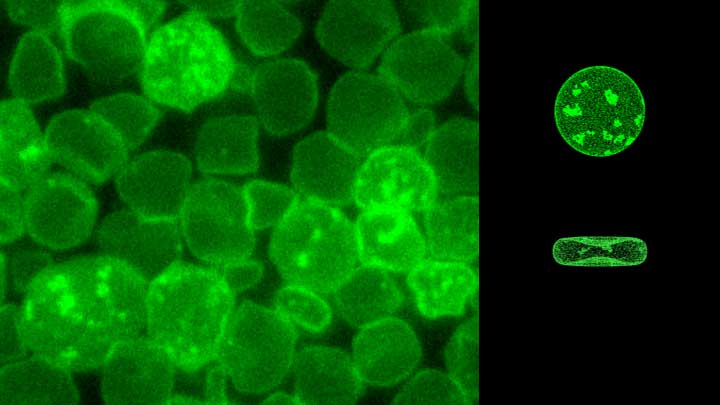TOP > News & Articles > Research Highlight > Aging blood cells grow “freckles”
Aging blood cells grow “freckles”

Most of our cells can maintain their function as they age by constantly replacing their constituent proteins and metabolites. Oxygen delivering red blood cells (RBCs) do not reproduce these constituents because they lack a nucleus and protein synthesis machinery. Instead, our body maintains a healthy RBC population by removing aged RBCs affected by oxidative stress from circulation and supplying new ones. While the life span of human RBC is normally around 120 days, some genetic conditions make RBCs more susceptible to oxidative stress and render the life span shorter. The molecular mechanisms behind RBC’s aging have been a focus of studies to understand these genetic conditions.
"The connection wasn't obvious between the changes in metabolites in RBCs and the timing of removal." explains Hanae Shimo of QBiC, the lead author of the paper published recently in PLoS Computational Biology[1]. "The appearance of patchy aggregations of Band 3 proteins on the surface of RBCs could trigger their removal. But we didn't know the details of how this clustering of Band 3 occurs." To visualize the movement of Band 3, one of the major membrane proteins on RBC surface, she took advantage of Spatiocite, a computer program developed by QBiC's Satya Arjunan, which can simulate stochastic molecular diffusion events. His simulation program combined with a kinetic model of RBCs antioxidant metabolism successfully described time dependent appearance of Band 3 clusters on the RBC surface under oxidative stress. The authors provided deeper understanding of the Band 3 clustering mechanism and predicted the clustering behavior under various conditions.
Shimo hopes these studies will improve our understanding of the physiology of anemia-associated RBC disorders and will aid in the quality control of stored RBCs used for blood transfusion as well.
- Shimo, H., Arjunan, S. N. V., Machiyama, H., Nishino, T., et al. "Particle Simulation of Oxidation Induced Band 3 Clustering in Human Erythrocytes" PLoS Comput. Biol. 11, e1004210 (2015) doi:10.1371/journal.pcbi.1004210

